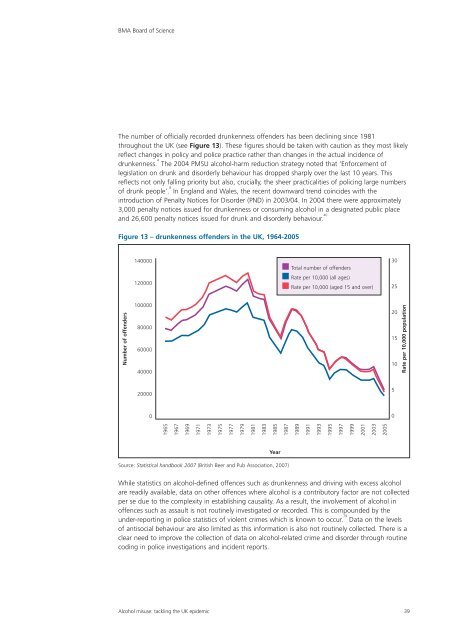Alcohol misuse: tackling the UK epidemic - London
Alcohol misuse: tackling the UK epidemic - London
Alcohol misuse: tackling the UK epidemic - London
You also want an ePaper? Increase the reach of your titles
YUMPU automatically turns print PDFs into web optimized ePapers that Google loves.
BMA Board of Science<br />
The number of officially recorded drunkenness offenders has been declining since 1981<br />
throughout <strong>the</strong> <strong>UK</strong> (see Figure 13). These figures should be taken with caution as <strong>the</strong>y most likely<br />
reflect changes in policy and police practice ra<strong>the</strong>r than changes in <strong>the</strong> actual incidence of<br />
drunkenness. 4<br />
The 2004 PMSU alcohol-harm reduction strategy noted that ‘Enforcement of<br />
legislation on drunk and disorderly behaviour has dropped sharply over <strong>the</strong> last 10 years. This<br />
reflects not only falling priority but also, crucially, <strong>the</strong> sheer practicalities of policing large numbers<br />
of drunk people’. 8<br />
In England and Wales, <strong>the</strong> recent downward trend coincides with <strong>the</strong><br />
introduction of Penalty Notices for Disorder (PND) in 2003/04. In 2004 <strong>the</strong>re were approximately<br />
3,000 penalty notices issued for drunkenness or consuming alcohol in a designated public place<br />
and 26,600 penalty notices issued for drunk and disorderly behaviour. 40<br />
Figure 13 – drunkenness offenders in <strong>the</strong> <strong>UK</strong>, 1964-2005<br />
Number of offenders<br />
140000<br />
120000<br />
100000<br />
80000<br />
60000<br />
40000<br />
20000<br />
0<br />
1965<br />
1967<br />
1969<br />
1971<br />
Source: Statistical handbook 2007 (British Beer and Pub Association, 2007)<br />
1973<br />
1975<br />
1977<br />
1979<br />
1981<br />
1983<br />
While statistics on alcohol-defined offences such as drunkenness and driving with excess alcohol<br />
are readily available, data on o<strong>the</strong>r offences where alcohol is a contributory factor are not collected<br />
per se due to <strong>the</strong> complexity in establishing causality. As a result, <strong>the</strong> involvement of alcohol in<br />
offences such as assault is not routinely investigated or recorded. This is compounded by <strong>the</strong><br />
under-reporting in police statistics of violent crimes which is known to occur. 79<br />
Data on <strong>the</strong> levels<br />
of antisocial behaviour are also limited as this information is also not routinely collected. There is a<br />
clear need to improve <strong>the</strong> collection of data on alcohol-related crime and disorder through routine<br />
coding in police investigations and incident reports.<br />
<strong>Alcohol</strong> <strong>misuse</strong>: <strong>tackling</strong> <strong>the</strong> <strong>UK</strong> <strong>epidemic</strong> 39<br />
1985<br />
Year<br />
1987<br />
Total number of offenders<br />
Rate per 10,000 (all ages)<br />
Rate per 10,000 (aged 15 and over)<br />
1989<br />
1991<br />
1993<br />
1995<br />
1997<br />
1999<br />
2001<br />
2003<br />
2005<br />
30<br />
25<br />
20<br />
15<br />
10<br />
5<br />
0<br />
Rate per 10,000 population
















